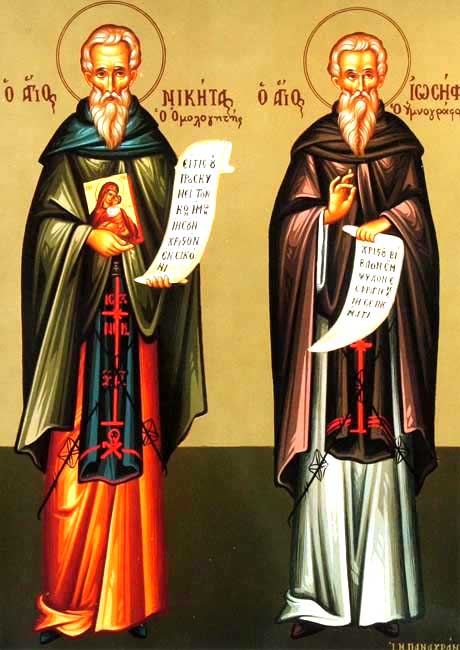 Our father Saint Niceta saw the light in Caesarea Bithynia. When his mother died, on the eighth day of his birth, he was dedicated to God as a new Samuel and joined a church to serve her. As for his father, Philart, he was an ascetic and a monk. The bishop of the city took him in and taught him the Holy Scriptures. When he was twelve years old, he was a reader.
Our father Saint Niceta saw the light in Caesarea Bithynia. When his mother died, on the eighth day of his birth, he was dedicated to God as a new Samuel and joined a church to serve her. As for his father, Philart, he was an ascetic and a monk. The bishop of the city took him in and taught him the Holy Scriptures. When he was twelve years old, he was a reader.
He was always thinking about what he said. The call to asceticism from the world penetrated deeply into his heart, so he decided, like his father, to leave everything, carry the cross, and follow the teacher.
He joined a saintly hermit named Stephen who was residing in a cave near the city. He remained in complete renunciation for some time, but the hermit advised him, for his own benefit, to join a monastery of communion. He said to him: “There you will find suffering that produces joy, and you will be able, by enduring the experiences of common life, to acquire discernment and advance upward to God.”
On the advice of the Sheikh, Niceta moved to the Monastery of the Medicians, which he had recently founded on Mount Olympus of Bithina, by Saint Nicephorus (May 4). He obeyed with distinction and loved his spiritual father without limits. His moderation and patience attracted the brothers, and they loved him. Five years later, Saint Thracius, the Patriarch, ordained him a priest. When he returned to the monastery, he was entrusted with managing the company, which numbered one hundred monks. With the grace of God residing in him, he predicted the future and healed the sick who were seeking refuge in the monastery. It was not long until he canceled himself alone, without his spiritual father, Nikephoros. He was forced, unwillingly, to accept the responsibility of heading the monastery.
At that time, around the year 815 AD, Leo V the Armenian renewed his campaign against icons and their venerators. As he hoped to attract the well-known heads of monasteries to his side, and through them the entire believing people, he invited them to Constantinople. Leo tried to woo Niceta. In refutation of the veneration of icons, Leo referred to what was stated in the Gospel of John (4:53). The true worshipers worship the Father in spirit and in truth because the Father seeks such worshipers. Niceta's answer was, with all boldness, that those who interpret divine words in this way deny the incarnation of the Lord Jesus Christ.
If the heretics’ arguments were proven invalid and the king feared the saint’s side, he threw him in prison. Then after this, he sent Niceta and his companions, on foot, in the depths of winter, to the fortress of Masali, in Asia Minor. As soon as they reached him, he sent them back to Constantinople.
Leo deceived them and asked them to participate in the sacred services with Theodotius, who was appointed by Leo as a replacement patriarch for the exiled Nikephoros. Niceta agreed after he was deceived and was falsely told that Theodotius venerated icons. After a while, Nakita discovered the deception and refused the company, so he was exiled to the island of Saint Galiceria, where he was tortured for six years.
When Leo died in 820 AD, peace returned. Nikita was released. But he did not return to the Medici Monastery because he considered himself unfit to hold the helm of the monastery ship. So he began to move between the islands near Constantinople, living to his Lord, alone, strengthening the support of the sick and needy with his prayers.
Finally, he settled in a corner near the Golden Horn overlooking Constantinople, where he lived like an earthly angel. A few months had passed when he fell ill and died. On April 3, 824 AD, his remains were transferred from there to the Monastery of the Medicites, where they were deposited next to Saint Nikephoros.
The church celebrates his feast on April 3.


